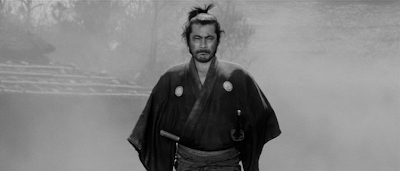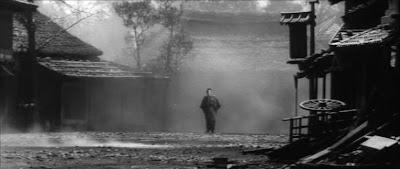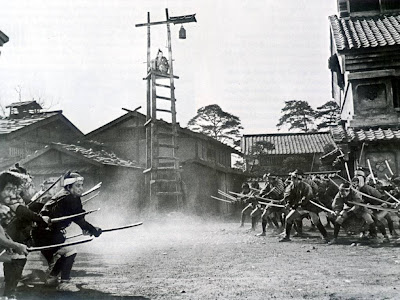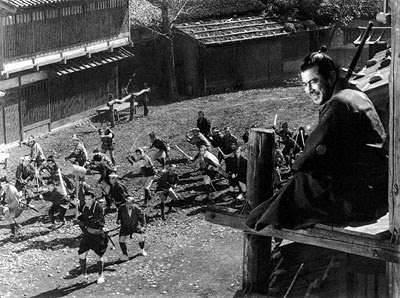Yojimbo, eh? Tell me about Yojimbo.
Nathaniel: Oh, look at the time! I'm sure Alex can tell everybody about Yojimbo.
 Alex: I can tell you a great many things, actually. A great many things. Like, Yojimbo tells the story of a ronin named Sanjuro who wanders into a small town filled with men of ill repute.
Alex: I can tell you a great many things, actually. A great many things. Like, Yojimbo tells the story of a ronin named Sanjuro who wanders into a small town filled with men of ill repute.And, throughout the film, Sanjuro plays each of the town's crime lords, not only getting them all to hire him for protection, but to eventually pit each man against another, leading to the wholesale destruction of the town.
So, it's kinda like Thanksgiving dinner for most of us.
What parts or aspects of the film really stood out to you?
Alex: Well, first off, we had previously viewed Ran, which was shot in color and was this huge, sprawling epic of a movie, filled with battles and hundreds of extras. And Yojimbo is certainly not that. It's a much smaller movie, with very little "movement," and few main players.
It's a small story, told on a pretty small scale, which surprised me a bit considering the other films we watched.
 Nathaniel: The opening credits sequence really struck me--the first few minutes of the movie consist of a continuous close-up shot of the back of the main character's head, and then a close-up of his legs and feet. And he's just... walking. It was like watching The Hidden Fortress all over again, but on a much smaller scale. This should have been boring as all get-out, but the acting was so nuanced; I really got a feel for who this character was just by watching the back of his head, which must be the mark of a good actor.
Nathaniel: The opening credits sequence really struck me--the first few minutes of the movie consist of a continuous close-up shot of the back of the main character's head, and then a close-up of his legs and feet. And he's just... walking. It was like watching The Hidden Fortress all over again, but on a much smaller scale. This should have been boring as all get-out, but the acting was so nuanced; I really got a feel for who this character was just by watching the back of his head, which must be the mark of a good actor.The other thing that stood out was how Sanjuro only removed his arms when he needed to use them.
Hang on; let me rephrase that sentence. Sanjuro kept his arms folded inside his clothes most of the time, and he'd only ever wiggle an arm back through the sleeve if he needed to open a door or cut someone in half.
 Oh, that's the other thing I noticed: while there were a few severed body parts, the violence in this movie felt a little less authentic than in Fortress and Ran--to give you an indication, I recall a moment where someone was getting beaten by the sharp side of a pointy sword, and only after several thwackings did he succumb to his beating-by-sword and fall to the ground. It wasn't cheesy violence, but the sharp objects in Fortress and Ran, which came before and after Yojimbo, respectively, were more convincing as deadly weapons.
Oh, that's the other thing I noticed: while there were a few severed body parts, the violence in this movie felt a little less authentic than in Fortress and Ran--to give you an indication, I recall a moment where someone was getting beaten by the sharp side of a pointy sword, and only after several thwackings did he succumb to his beating-by-sword and fall to the ground. It wasn't cheesy violence, but the sharp objects in Fortress and Ran, which came before and after Yojimbo, respectively, were more convincing as deadly weapons.Speaking of deadly weapons, there's one guy with a gun--the only gun in the movie--who felt a little out of place because he had the only gun in the movie, he reminded me vaguely of a clown, and his outfit somehow looked more like it belonged in the time period when the movie was made than the time period in which the movie was supposed to take place. This was surely intentional and I must be an uncultured yokel not to realize the artistic value here, but I call it like I see it.
What did you think about the music?
Alex: Sometimes it worked, sometimes it...um...didn't. Overall, though, it really didn't add to or detract from my viewing experience.
 Nathaniel: Although by now I can't call to mind a single melody from the movie, I distinctly remember stating that the music sounded as though there was a nice orchestra playing with a single eight-year-old child running amok and playing with instruments here and there. Sometimes a particularly upbeat and fairly nonstandard instrument would shine through and remind me that (a) this movie is not supposed to be overwhelmingly serious, and (b) this movie was made in the early '60s.
Nathaniel: Although by now I can't call to mind a single melody from the movie, I distinctly remember stating that the music sounded as though there was a nice orchestra playing with a single eight-year-old child running amok and playing with instruments here and there. Sometimes a particularly upbeat and fairly nonstandard instrument would shine through and remind me that (a) this movie is not supposed to be overwhelmingly serious, and (b) this movie was made in the early '60s.What about the acting? Rate it, if you would.
Alex: Sometimes I think I can play Kurosawa's main character--"brooding, scowling, arms always crossed." I think I fit that bill quite nicely, actually.
One of the things I've noticed is that, especially the smaller roles tend to be a bit over the top. Some over-acting, for sure, but the main players all deliver quality performances.
 Nathaniel: It might just be that I don't speak Japanese, but I've never heard a bad Japanese actor, in live action or anime. At least as far as the dialogue goes, everybody did just fine. I had no qualms about the other aspects of the acting, though I will second Alex's observation that the bit parts are over-the-top, but no so much that it derails the show.
Nathaniel: It might just be that I don't speak Japanese, but I've never heard a bad Japanese actor, in live action or anime. At least as far as the dialogue goes, everybody did just fine. I had no qualms about the other aspects of the acting, though I will second Alex's observation that the bit parts are over-the-top, but no so much that it derails the show.Gotta love how we both failed to respond to the "Rate it, if you would" part of the question we came up with ourselves.
Is there a point in Yojimbo when your interest wanes? How does this compare to the other two films?
Nathaniel: Fortress got a little slow from time to time, but the dialogue, characters, and cinematography were enough to keep me engaged; Ran was difficult to sit through because of its sprawling exposition, lack of movement, and subject matter (war, political intrigue, and other things that aren't my bag).
Yojimbo arguably had the best pacing of the three we've seen, but despite its numerous action sequences and creative twists, I found that I wasn't fully invested in the characters one way or another, so my attention waned when the movie focused more on the characters than the action and plot twists.
 Alex: I think I might have checked out of this film earlier than I would have liked. Maybe because it was relatively short, maybe because there was a ton of exposition in the first ten or fifteen minutes. Either way, I didn't really get into the movie until pretty close to the end, and things were getting ugly in the town.
Alex: I think I might have checked out of this film earlier than I would have liked. Maybe because it was relatively short, maybe because there was a ton of exposition in the first ten or fifteen minutes. Either way, I didn't really get into the movie until pretty close to the end, and things were getting ugly in the town.Now, to be fair, there were extenuating circumstances while trying to watch this movie that likely played into my early zone-out. My main DVD player decided that it didn't want to play this particular disc, and instead of accepting this fact and moving on, Nathaniel and I tried to "fix" the DVD player.
 When that didn't work (at all), we ended up playing it on another screen, in a room with decidedly less comfortable seating. I was in my computer chair as opposed to being on the big, comfy couch, and Nathaniel was in a round wicker thing that I bought from Pier One many moons ago.
When that didn't work (at all), we ended up playing it on another screen, in a room with decidedly less comfortable seating. I was in my computer chair as opposed to being on the big, comfy couch, and Nathaniel was in a round wicker thing that I bought from Pier One many moons ago.And all the snacks were downstairs, so that made me a little grumpy.
You've now seen three Kurosawa films. What do you think of him as a director? As a storyteller?
Alex: He's deliberate in his pacing. There's a lot that needs to be set up early on in his films, and instead of showing the audience, he tells them. Still, he never rushes things, which is something that I admire.
He certainly sets out with a vision, and he makes sure that he delivers the film he wants people to see. And that's something we don't get from more recent directors who bow to production companies and movie studios too often and allow the work to suffer.
Kurosawa definitely has integrity as a filmmaker, that's for sure.
 Nathaniel: What he said.
Nathaniel: What he said.How does Yojimbo compare to Ran and The Hidden Fortress?
Alex: Well, it's much shorter, for one. And it's told on much less of a scale. It's a more intimate flick, and we really get to see the political strategy (and the mindset) of the main characters.
 Nathaniel: In addition to what I've already said, Yojimbo felt more American than the other two. Lots of fighting, Also, several characters--actual characters, mind you; not just extras--get killed off just because they were in the wrong place or did something to sufficiently irritate somebody else. If anybody died in Ran or Fortress, they were either inconsequential or so pivotal to the plot that their death was a big event. In Yojimbo, characters just... died.
Nathaniel: In addition to what I've already said, Yojimbo felt more American than the other two. Lots of fighting, Also, several characters--actual characters, mind you; not just extras--get killed off just because they were in the wrong place or did something to sufficiently irritate somebody else. If anybody died in Ran or Fortress, they were either inconsequential or so pivotal to the plot that their death was a big event. In Yojimbo, characters just... died.These movies all have long running times. Could these films be released in today's film industry?
Nathaniel: After Lord of the Rings and King Kong made epic-length movies the rule, not the exception, the fact that this clocked in at barely under two hours makes me wonder if it's long enough!
 Alex: There'd need to be more explosions, a nude scene, and Seth Rogen.
Alex: There'd need to be more explosions, a nude scene, and Seth Rogen.Would you recommend Yojimbo as a good starting point for newcomers to Kurosawa's work? How about the other two films we watched?
Alex: I think Nathaniel and I started at a good place with The Hidden Fortress. It's not usually the film at the top of fans' lists, but I think that it made sense as a way to introduce us to the work.
 Nathaniel: If the newcomer in question is a big fan of Westerns or has no interest in big armies gathering on broad hilltops, then Yojimbo is a great place to start.
Nathaniel: If the newcomer in question is a big fan of Westerns or has no interest in big armies gathering on broad hilltops, then Yojimbo is a great place to start.I suspect there needs to be a common ground between the film being watched and the interests and/or experience of the viewer; Fortress was a great place for me to start because I had heard the film had influenced Star Wars, but I could have just as easily started with Yojimbo because I'm finding more and more that I really like Westerns. Ran would not have been an ideal introduction for me because it wasn't my style of movie on a number of levels, but there are elements that would be wildly appealing to a different audience.
 Honestly, any of the films we've seen so far would be good introductions to Kurosawa's work; it just depends on who the victi--erm, viewer is.
Honestly, any of the films we've seen so far would be good introductions to Kurosawa's work; it just depends on who the victi--erm, viewer is.Was it better than doing a road trip to local tourist traps?
Nathaniel: I think Alex's house counts as a tourist trap--he promised we'd watch Yojimbo on a big-screen TV, but we ended up watching it on a smaller TV in his room, and I left with a $35 baseball cap that says "I didn't watch Yojimbo on a big-screen TV"--so I'd say we got the best of both worlds.
Alex: Considering that our options were limited to driving to Danbury to go see a lawn somewhere with a tilted rock balancing on two other rocks...yes.
Yes, it was.

4 comments:
Some things to consider...
One, his name isn't Sanjuurou -- I don't know if there was anything to explain this or if you've read about it, but it was a very obviously fake name. Sanjuurou just means "30-year old guy" and Kuwabatake is just what he happened to see outside -- a berry field.
Two, do you think the movie felt more American because of American influences on Japan at the time, or because this film influenced so many American filmmakers that made popular films that we've seen?
Three, the guy who played Sanjuurou is Mifune Toshirou and he's an absolutely legendary Japanese actor. He also stared in a film series called Musashi, playing the eponymous swordsman. Definitely look it up if you ever feel like it.
I did not get that with his name--thanks for bringing that to our attention. There was no explanation given, and his name, when it was mentioned in the subtitles by the other characters, was simply "Sanjuro," and not the English translation.
But, being that Yojimbo was a direct precursor to the "Man with No Name" films, that makes a lot of sense.
Also, I mentioned in our review of Ran that that movie felt "American" to me, but I wasn't sure if it was because so many American directors were influenced by (and had outright copied, in some cases)Kurosawa. The same goes with this film.
And I didn't mean my little joke to be a shot at the actor at all. He was great in the film--as are all of the main players in the movies we've watched.
As I said, some of the bit parts in Yojimbo felt like they were over-the-top to me. But, the dialogue-heavy script makes it neccesaary for the main actors (Toshirou especially) to really give strong performances, and they did (both delivering lines and reacting to the lines of others).
Personally, I'm not well-versed in film history and who influenced who. It felt American because it reminded me of a few Westerns I've seen and because the style of the film was similar to the style I've seen in countless American films. Frequent action, everything happens within the confines of a single location, camera shots weren't super zoomed-out to look at the landscape nor super zoomed-in to stare at the characters most of the time... that kind of thing. It's hard for me to say what's coincidence and what's influence, one way or another.
The funny thing is, if you start reading/watching a lot of manga or anime, you'll see that the techniques are relatively similar to what Nathaniel just mentioned -- lots of action, simple settings, and focus on the faces (especially eyes). And modern-day directors are saying that they're being influenced by anime... what a cycle.
Japanese people tend to wear masks when they're sick or think they might catch something; it's interesting how comfortable Japanese people feel when all they can see are the eyes. It makes me feel really UNcomfortable. There was an article I read at one point that discussed the differences in Japanese and American text-based emoticons -- a lot of the Japanese ones are based on the eyes, whereas all of the American ones are based on the mouth.
Post a Comment